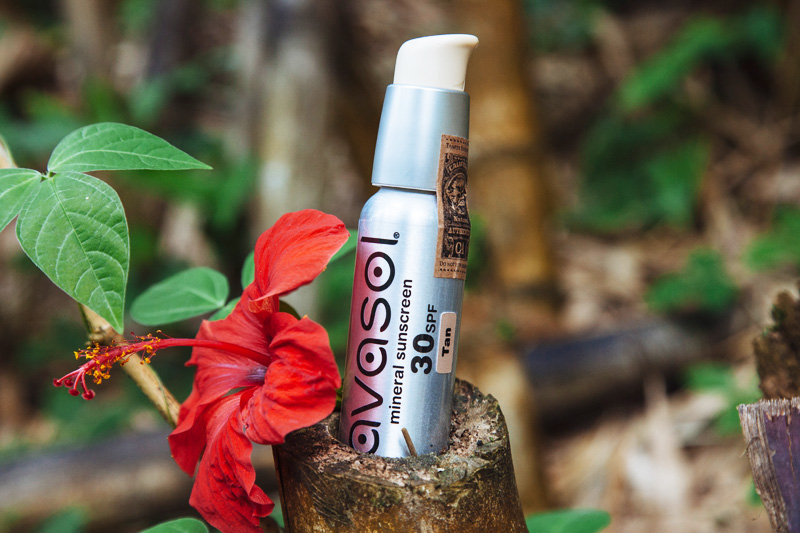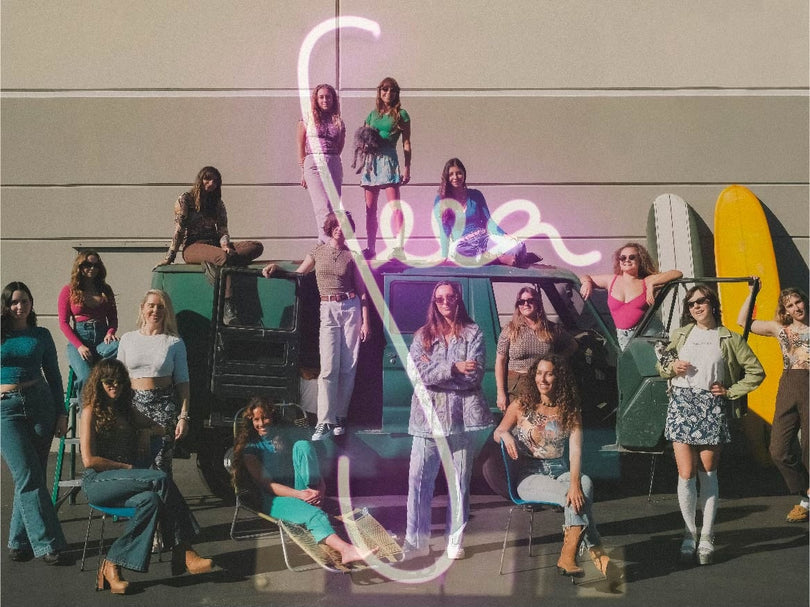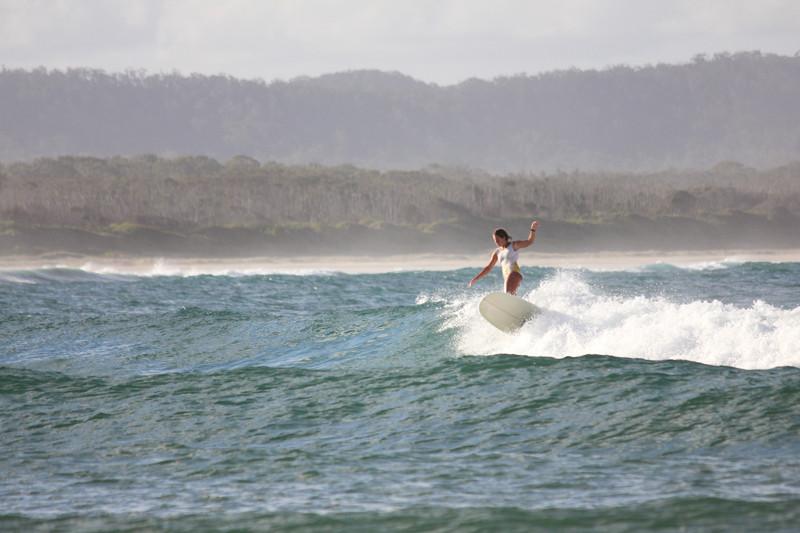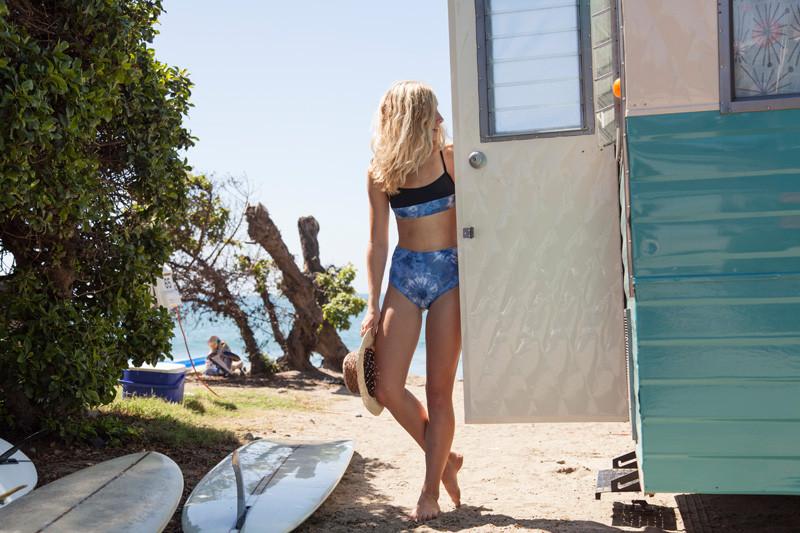 |
| Leah Dawson pumps Avasol sunscreen into her palm. |
If our skin is the largest organ of our bodies, why don't we feed it with the same high standards of organic greens that we eat? During our hunt for a sunscreen isn't made with harmful ingredients and nourishes the skin, yet still stays on during long sessions, Seeababe Leah Dawson introduced us to Avasol.
From first-hand experience, she praises Avasol sunscreens for their efficacy in the waves and high quality ingredients without relying on traditional (and toxic) sunscreeen components such as reef-killing Oxybenzone, harmful nano-particles and parabens.
Avasol is made from wholesome ingredients — many of which are safe enough to eat. “For surfing, I like to wear Seea gear that covers a good portion of my skin, and use non-toxic sunscreen to cover and protect the rest that is exposed,” Leah says of her skin care regimen. She continued, “I’ve been using Avasol for two years now, both their face stick and their cream,” Leah tells us. “The sunblock always stays on my face, even if I have a long four-hour surf session. The cream needs to be reapplied every couple of hours, but I tend to wear full-body gear anyways if I expect to be out for a long session.”
Founder and owner, Chris Wilkinson started Avasol from scratch after failing to find options in the market that were up to his environmental standards. Both Chris and Leah offer us some advice for choosing sunscreen and why it’s up to consumers to choose products that are healthy for our bodies and the environment.
 |
| Leah smears the Avasol stick on her face before paddling out. Photo by Luki O'Keefe. |
What are the harmful effects of traditional sunscreen products?
Leah: Parabens of all types have been found most harmful. Traces of them have been found in breast cancer tumors. Parabens are often found in shampoos, conditions, lotions, sunscreens, and perfumes. Scary. Johnson & Johnson recently released that they are removing all parabens from their baby products by 2016. It’s about time.
The industry has gotten away with harming us for too long. Consumers must change the market!
Avasol’s use of wholesome products keeps the products reef and ocean safe. Nearly every sunscreen brand found at the normal market in America is filled with nano-particals of zinc oxide and titanium dioxide, which have been found harmful for both human skin and ocean reefs.
My friends at the Keep A Breast Foundation created another organization called the Non-Toxic Revolution, raising awareness about the toxic consumer industry, and the dangerous products we need to be aware of. Unfortunately, our present FDA doesn’t regulate against thousands of dangerous chemicals spread throughout our marketplace, so we must assume the responsibility as consumers to do our own research, read labels, and buy products that we know and trust are not harmful to us and our families. It is only by refusing to buy dangerous products that the big corporations making them will lose their power over the marketplace.
Chris: There are multiple compounds in most commercial sunscreens that are a very real concern. These common active ingredients are known hormone disruptors. This fact is not new and it is not debated. They are generally synthetic and/or petrochemical in origin. You may think that you’re safe substituting Avobenzone instead of Oxybenzone, but the fact is that commercial sunscreens contain chemical combinations that have never been tested for their safety. This includes the stabilizers and skin penetration enhancers, the rest of the toxic stuff used to preserve it and make it look and smell pretty.
These ingredients in combination are known to act synergistically in a harmful way. Yet while the FDA is aware that the ingredients in most sunscreen are toxic, they claim that that the risk of skin cancer outweighs the toxic ingredients. To add to the confusion, they also state that, “The FDA is not aware of data demonstrating that sunscreen use alone helps prevent skin cancer.” It is also a known fact that most commercial sunscreens fail to adequately protect against UVA.
Chris, where did your research to create Avasol start?
Chris: Since no one was coming to the rescue with a sunscreen that met my stringent requirements of functionality, quality and sustainability, I had to start from scratch. Looking back, it was that vacuum that pushed me to the out-of-the-box thinking that was needed. The question began as “what were our ancestors doing centuries ago to protect themselves”? Some of the evidence even pre-dates written history, but it became clear that there was a better way, and none of it included synthetic UV absorbers, petrochemicals, or nano particle sized minerals.
What are the benefits of using wholesome ingredients?
Chris: The unexpected benefits are abundant and significant, because I was studying for clues in ethno-pharmacology, or indigenous/traditional medicine. It makes sense that what was used for millennia to treat and protect the skin might have modern application too. Since the FDA regulates sunscreen as a drug, manufacturers may not make medical claims other than “may prevent sunburn,” but it’s pretty obvious the variety of benefits that might be derived from using traditional medicinals as your base.
The antioxidant laden ingredients that I found were the biggest lesson, not just the ones that you put on your skin, but the ones that you eat! Not only are antioxidants good for protecting you from sun damage, but it is essential for your health in general. Visible changes in people's skin and anti-aging benefits are no small thing for many of people, and one of the most popular side benefits with our products.
 |
| Avasol's biodegradable packaging. Photo by Luki O'Keefe. |
 |
| Avasol cream. Refill packages available to reduce plastic waste. Photo by Luki O'Keefe. |
Chris: Today, it seems that marketing and misleading go hand in hand - ranging from subtle overstatements to outright and blatant lies. Greenwashing preys on peoples desire to do the right thing, and the fact is that it is confusing and time-consuming to understand it all. By far, the hall of shame award should go to the company who trademarked the term “reef safe”, yet who use the exact ingredients [Oxybenzone, etc.] that are proven to kill the reefs.
Perhaps there are companies who are simply ignorant, but the results are the same. Simply containing mineral actives, like Zinc Oxide and Titanium Dioxide, does not make a product safe, especially if it is in nano particle form and if the rest of the ingredients are known to be toxic. What about the “all natural,” “reef safe” sunscreen that contains Alumina, which is known to kill fish and other aquatic life? I could go on, and on… There are no perfect solutions, and humans tend to damage the environment regardless. My goal was to simply do the very best that I could, without regard to cost, or the nay-sayers. It is an exciting process to continually find ways to do it better and with less impact.
What are the red flags consumers look for when choosing sunscreen to ensure it’s healthy for their body, and reef safe?
Chris: Unfortunately the terms “Organic”, “Natural”, “non-nano” and “Reef Safe” are now huge red flags for me. Manufacturers rely on the fact that most people don’t bother to flip the product over and read the ingredients. And if they do, the chances are that they won’t understand anyway.
Considering that the safest active ingredients for sunscreens are “Inorganic” minerals, claiming that a sunscreen is “Organic” is confusing and totally misleading.
Bottom line, if your sunscreen is clear, it’s probably not safe. The safety of clear sunscreens is impossible—both standard and mineral types. Any time you see a formula that is clear, it is going to either contain UV absorbing actives like Oxybenzone, etc., or if it’s a mineral formula, it will contain nano-particles. There is currently no regulation on disclosure of nanoparticles, so many products that now claim to be ‘non-nano’ are also clear!? So we must decipher between claims of ‘natural’, ‘mineral’, ‘organic’, ‘reef-friendly’ sunscreens, by reading the labels and making sure the product is not invisible when rubbed into the skin.
A non-toxic, non-nano particle based sunscreen will always come in the form of a visible, ‘physical barrier’.
What other ingredients should consumers look for in their sunscreen to determine if they are responsibly made?
Chris: While “Chemical-sounding names” can be a warning, “Chemical Free” is a huge red flag too. Zinc Oxide [ZNO] and water [H2O] are technically chemicals, so this is really misleading. Look for and avoid ingredients that are derived from petroleum - Petrolatum, Mineral oil, polyethylene (PEGs), etc are but a few examples. Also, avoid ingredients ending in …cone, as these are silicone derivatives. Obviously, avoid anything related to parabens. Synthetic “fragrance” or “parfum” is a big one to avoid. When in doubt, look it up.
The number of ingredients in a formula and your ability to pronounce them has no real basis to judge a product. Even the safest botanicals must be listed in their Latin name, so good luck using pronunciation as a measure of safety. But DO watch out for companies who make it difficult to find both the active and inactive ingredients. By law, it has to be on the product package, but many leave it off their website, making it difficult to do your research.
Here is great tip to make you a sunscreen detective or in any personal care product — look for water as an ingredient. The first reason is that if there’s water, there MUST be a chemical preservative, and likely an emulsifier too. If you are an active, outdoor person, a surfer, or simply don’t want to pay for a cheap filler that increases the likelihood of toxic chemical ingredients, think about this… if it’s a water-based formula, isn’t it way more likely to wash right off in the water? Or sweat off?
On that topic, any sunscreen that claims “Waterproof” is basically bogus.
 |
| After lathering up, Leah goes for a surf in the Solanas Surf Suit. Photo by Luki O'Keefe. |
 |
| Leah in the Solanas Surf Suit. Photo by Luki O'Keefe. |
Do sunscreens really prevent skin cancer? What regulations are in place to protect consumers?
Chris: If your sunscreen promises to prevent skin cancer, know that this is designed more to promote fear and increase sales than to protect and educate… But it is time to start looking at the entire picture and considering other factors in our lifestyles, diet and environment. We know that what you eat plays just as big a part in protecting you from the sun and preventing cancers. What about all of the other toxins and carcinogens we expose ourselves to on a daily basis? What if they acted as a catalyst?
It is also critically important to understand that making sunscreen is serious business and it is strictly regulated by the FDA. While the FDA allows a lot of questionable and flat out toxic things in commercial sunscreen and personal care products, they also require a lot of extremely important safety testing. If a company even remotely suggests that a product might protect you from the sun, it’s sunscreen - there is no way around it. It is tempting to support small start-ups, especially if they are trying to do the right thing by making an “organic” product. But, did they do an actual SPF test? What about water resistance tests? What about clinical/allergy testing? Is each and every ingredient tested on every batch? Did they audit the suppliers for their organic, or sustainability claims?
Avasol started in the kitchen too, but there are no excuses for knowingly cutting corners. There is a right way, and a wrong way… Know that Avasol is legit, and has done all of the required testing, and more. Feel free to make it in your kitchen yourself, if you are so inclined [*I will even give you an open-source formula]. It’s just not worth the risk to support sunscreen manufacturers who don’t bother to be street legal. If they don’t do any testing, or register with the FDA, what else are they cutting corners on?
Do a search here to see if a company is legitimate and registered with the FDA.
Thanks Chris and Leah for this wealth of knowledge! To shop these products and more answers to your own sunscreen questions, go to Avasol.com.
MORE STORIES FOR YOUR HEALTH:
- 3 Yoga Stretches for Surfers by I Love Waves
- Kauai Juice Co.'s beverage cures for post-surf hydration, a hangover or beating a cold








2 comments
Seea
Hi Stephanie! You may email Avasol for the formula to try it out! http://www.avasol.com/contact.htm
thanks! SEEA
Hi Stephanie! You may email Avasol for the formula to try it out! http://www.avasol.com/contact.htm
thanks! SEEA
Stephanie
This is a great article. I love that you looked into the value of “ethno-pharmacology” for some ingredient inspirations! How can we access this "open source formula to try in our own kitchen?
This is a great article. I love that you looked into the value of “ethno-pharmacology” for some ingredient inspirations! How can we access this "open source formula to try in our own kitchen?